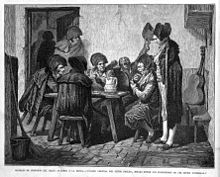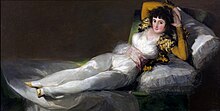Manolo

Manolo is a colloquial derivation of the name Manuel, and since the end of the XVIII century, by a famous skit by Ramón de la Cruz (1769), it is used as a synonym for handsome, brave or chulo, the traits with which that the popular classes of Madrid were identified, in a way equivalent to the concept of majo (for women, manola and maja) and in relationship with those of chulapo and chispero.
The expression majismo is also used to designate the traditionalist love of the aristocracy for the clothing and customs of manolos and majos of both sexes, including music, dances and popular entertainment (fandango, bullfighting, etc.); in opposition to French fashion (represented by its counterfigure: the fop—upper-class, mannered and idle young man—) and even to the values of the Enlightenment.
Manolos and Goyesque majos


Majos and majas are the characters who immortalized Goya's paintings of popular scenes, especially his series of cartoons for tapestry (La maja y los embozados, La cometa), or the famous The naked maja and The dressed maja (although the personality of the sitter is the subject of debate). The traditionalism of the Spanish aristocracy made them imitate the clothing and pose of the 'manolos', so it is common for Goya to also paint nobles with similar clothing. In a more tragic way, "manolos" or "nice" in the characters that appear in Dos de mayo de 1808 and in The executions of the third of May.
Simultaneously (and with evident results of social integration, see Pan y Toros) bullfighting on foot was developed, which turned these popular characters into heroes and lifted them out of poverty (previously bullfighting on horseback was preferred, reserved for the nobility), so the so-called "goyesco" (hair net for both sexes; fitted and low-cut bodice, scarf, puff sleeves and full skirt with apron for women; and neck scarf, jacket, knee-length pants and stockings for men) immortalized in the series of engravings Bullfighting became that of bullfighters, evolving during the 19th century to the current costume of lights.
We must remember that the protagonism of the masses in Spanish history, and very specifically in Madrid, began to be perceived since the Esquilache mutiny (1766), and later became evident in the War of Independence (1808). The ambivalent nature of this protagonism is also found in the figure of 'manolo', which can be understood as both an admiring and derogatory epithet, depending on the intention of the person who uses it. From an enlightened point of view, it could be considered the summary of all the vices of a people mired in backwardness. From a traditionalist point of view, of the virtues of the Spanish race. Goya's position is much more complex, and takes part of both. Most of the intellectuals at the end of the XVIII century took a clear stance against makhism; Jovellanos even denounced the miserable imitation of the free and indecent dances of the lowest plebs.



The words majo and maja are also used in reference to Goya's work. This is the case of Granados (Goyescas - The Majos in love) and Manet (Boy in a majo suit). Manolismo is found in numerous European works of the 19th century as an imaginative representation of Hispanic stereotypes, of which the opera Carmen (Bizet) is one of the most notable representatives.
Manolos, majos, chulapos and chisperos
For some time there was a certain rivalry between manolos and manolas, names assigned to the inhabitants of the Lavapiés neighborhood (which would have its origin in the profusion of the name Manuel, with which it is said that many Jewish converts were baptized, although in other sources this custom is associated with the Moriscos), and the chulapos and chulapas, names assigned to those of the neighborhood from Malasaña or Maravillas, also called majos. Nowadays these terms are usually used interchangeably (but not majo or maja, which is reserved for the male and female Goya costume) to refer to people dressed in traditional Madrid attire, established by the zarzuelas of the end of the century XIX and beginning of the century XX (for example, in La verbena de la Paloma):
...sheet or vest with carnage on the flap, dark and tight pants, black hat on pictures, boots and white scarf on the neck and they with head scarf with red or white carnnel, white blouse and adjusted with a skirt of polka dots or dress typical of polka dots to the feet and manton of Manila.
The chulapos were also known as "chisperos", because their neighborhood was where a large number of blacksmith shops were concentrated, and many of their waiters were blacksmiths. The blacksmiths were called chisperos because of the sparks with which they came into contact as consequence of his job in the forge. The lighter or lighter is also called a spark, particularly the old one, which consisted of obtaining a spark from a stone or flint to ignite tinder or a rope wick. There is also a spark rocket.
Contenido relacionado
Enrique Molina
Italo Calvino
Case (grammar)